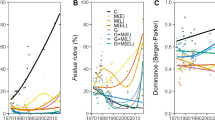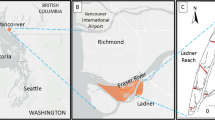Abstract
An increase in salt marsh restoration efforts,especially over the last two decades, underscores theneed for effective methods to evaluate long-termsuccess. Most marsh restoration/creation efforts areonly evaluated over the first few years afterestablishment and in many cases only vegetativecharacteristics are examined. This study examinesvegetation as well as dominance and abundance patternsof benthic infauna at three created marsh sites ofvarying ages in Winyah Bay, South Carolina, and acreated marsh site in North Carolina, using data fromearlier studies and from sampling undertaken in 1998. Abundances fluctuated strongly between years, withpatterns of numerical abundance changing betweensites. In contrast, species dominance as measured bypercent occurrence tended to remain constant afterestablishment of a site. The same suite of specieswas dominant at all sites regardless of marsh age oryear of sampling. These results indicate that whilefaunal abundance is an important factor in determiningmarsh function (i.e., are higher trophic levelssupported?), dominance may be as useful in monitoringstability, especially in areas where the faunalassemblage is not closely tied to the vegetativecommunity.
Similar content being viewed by others
References
Bishop, T.D. and Hackney, C.T. 1987. A comparative study of the mollusc communities of two oligohaline intertidal marshes: Spatial and temporal distribution of abundance and biomass. Estuaries 10: 141–152.
Broome, S.W., Seneca, E.D. and Woodhouse, W.W. Jr. 1986. Longterm growth and development of transplants of the salt-marsh grass Spartina alterniflora. Estuaries 9: 63–74.
Cammen, L.M., Seneca, E.D. and Copeland, B.J. 1976. Animal Colonization of Man-Initiated Salt Marshes on Dredge Spoil. Technical paper no. 76-7. U.S. Army Corps of Engineers, Coastal Engineering Research Center, Fort Belvoir, Virginia, USA.
Capehart, A.A. and Hackney, C.T. 1989. The potential role of roots and rhizomes in structuring salt marsh benthic communities. Estuaries 12: 119–122.
Fox, R.S. and Ruppert, E.E. 1985. Shallow-Water Marine Benthic Macroinvertebrates of South Carolina. University of South Carolina Press, South Carolina, USA.
Heard, R.W. 1982. Guide to Common Tidal Marsh Invertebrates of the Northeastern Gulf of Mexico. Mississippi-Alabama Sea Grant Consortium, Biloxi, Mississippi, USA.
Kneib, R.T. 1984. Patterns of invertebrate distribution and abundance in the intertidal salt marsh: Causes and questions. Estuaries 7: 392–412.
LaSalle, M.W., Landin, M.C. and Sims, J.G. 1991. Evaluation of the flora and fauna of a Spartina alterniflora marsh established on dredged material in Winyah Bay, South Carolina. Wetlands: 191–208.
Levin, L.A., Talley, D. and Thayer, G. 1996. Succession of macrobenthos in a created salt marsh. Marine Ecology Progress Series 141: 67–82.
Levin, L.A., Talley, T.S. and Hewitt, J. 1998. Macrobenthos of Spartina foliosa (Pacific cordgrass) salt marshes in Southern California: Community structure and comparison to a Pacific mudflat and a Spartina alterniflora (Atlantic smooth cordgrass) marsh. Estuaries 21: 129–144.
Mallin, A.M., Posey, M.H., Moser, M.L., Shank, G.C., McIver, M.R., Alphin, T.D. and Merritt, J.F. 1998. Environmental Assessment of the Lower Cape Fear River system, 1997-1998. UNCW Press, Wilmington, North Carolina, USA.
Moy, L.D. and Levin, L.A. 1991. Are Spartina marshes a replaceable resource? A functional approach to evaluation of marsh creation efforts. Estuaries 14: 1–16.
Posey, M.H., Alphin, T.D. and Powell, C.M. 1997. Plant and infaunal communities associated with a created marsh. Estuaries 20: 42–47.
Sacco, J.N., Seneca, E.D. and Wentworth, T.R. 1994. Infaunal community development of artificially established salt marshes in North Carolina. Estuaries 17: 489–500.
Simenstad, C.A. and Thom, R.M. 1996. Functional equivalency trajectories of the restored Gog-Le-Hi-Te estuarine wetland. Ecological Applications 6: 38–56.
Sokal, R.R. and Rohlf, F.J. 1981. Biometry. W.H. Freeman, San Francisco, California, USA.
Streever, W.J. 2000. Spartina alterniflora marshes on dredged material: A critical review of the ongoing debate over success. Wetlands Ecology and Management 8: 295–316.
Subrahmanyam, C.B., Kruczynski, W.L. and Drake, S.H. 1976. Studies on the animal communities in two north Florida salt marshes. Part II. Macroinvertebrate communities. Bulletin of Marine Science 26: 172–195.
Wenner, E.L. and Beatty, H.R. 1988. Macrobenthic communities from wetland impoundments and adjacent open marsh habitats in South Carolina. Estuaries 11: 29–44.
Woodhouse, W.W., Seneca, E.D. and Broome, S.W. 1972. Marsh Building with Dredge Spoil in North Carolina. Agricultural Experiment Station Bulletin # 445. North Carolina State University, Raleigh, North Carolina, USA.
Author information
Authors and Affiliations
Rights and permissions
About this article
Cite this article
Alphin, T.D., Posey, M.H. Long-term trends in vegetation dominance and infaunal community composition in created marshes. Wetlands Ecology and Management 8, 317–325 (2000). https://doi.org/10.1023/A:1008435319922
Issue Date:
DOI: https://doi.org/10.1023/A:1008435319922




